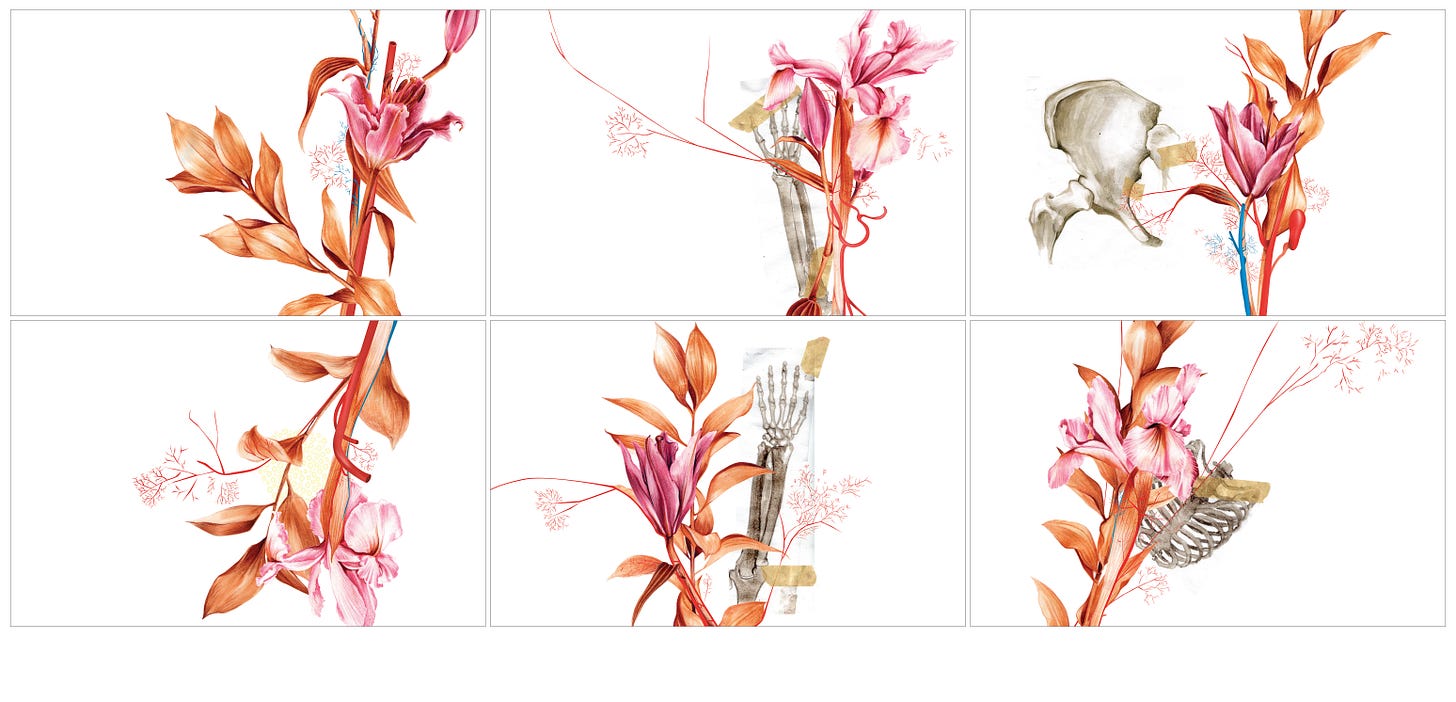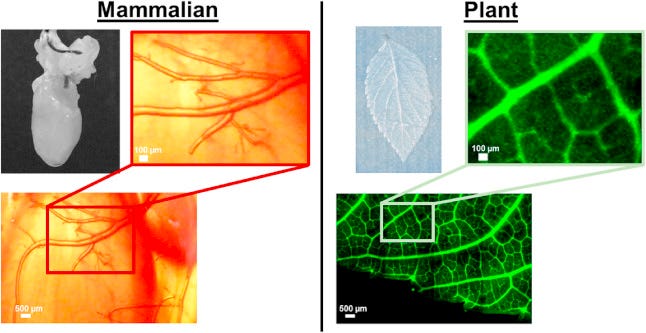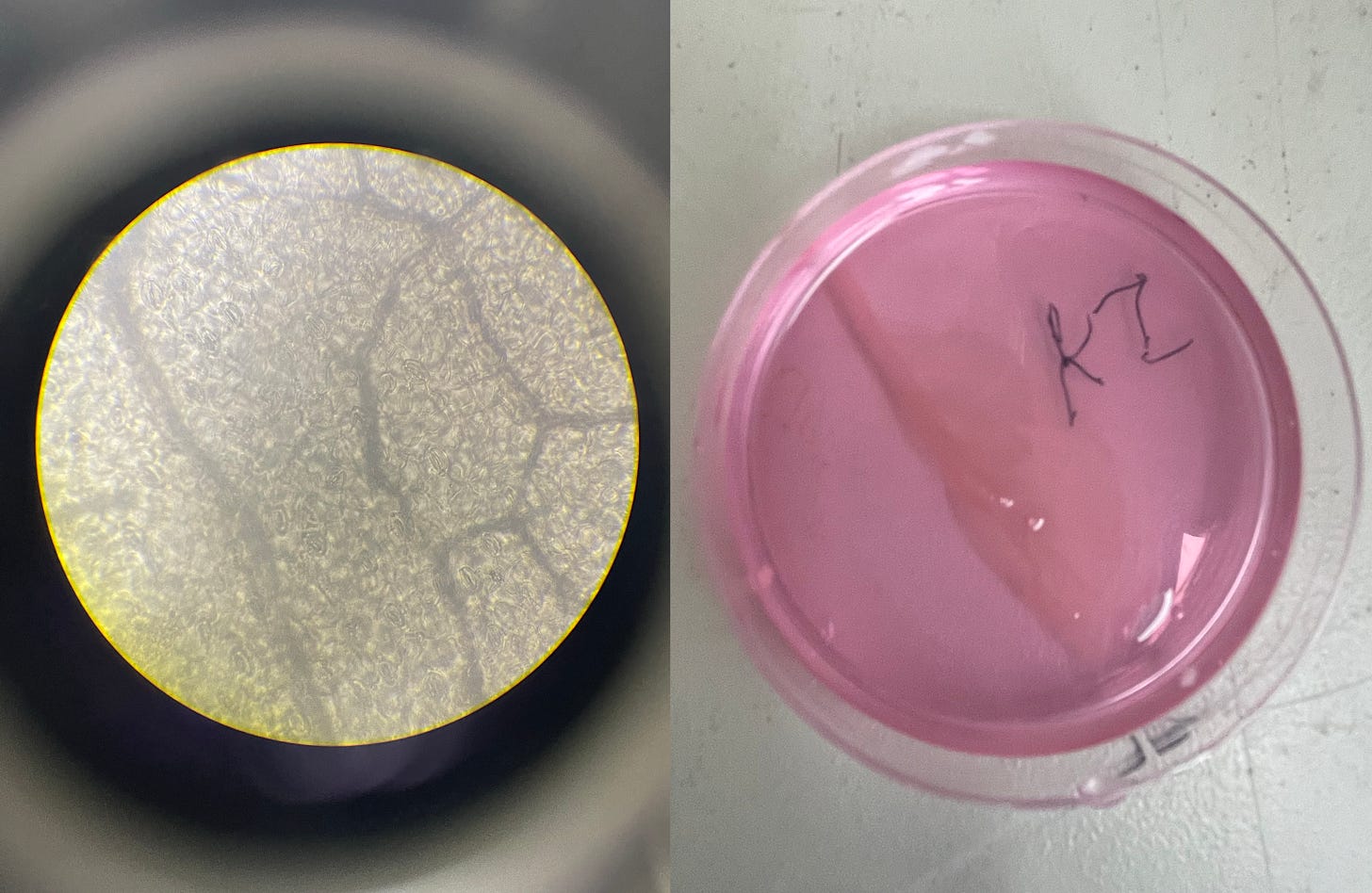Fleur de Lis (Why Flowers?)
"Fleur de Lis," emerging, existing, and extinct tools, plants as scaffolds for animal cells, and a meat leaf.

“Fleur de Lis”
At a time when the “digital hand” was very visible in art and design, I sought to blend the digitally created forms with hand-drawn elements, and “Fleur de Lis” is a favorite of my creations from that time. “Fleur de Lis” was inspired by my observations of cut flowers, specifically irises and tulips. As I regarded the glistening textures of flower petals and leaves, I imagined the flowers repurposed as organs (pink) and musculature (copper). Tulips in their bulbous bladder-like shapes, and irises with their complicated anatomy of sepals and stigmas, resembling the ventricles and valves of the heart. I pushed that vision further, incorporating arteries, vessels, capillaries, fat cells, and little bone structures in the composition like they are taped with masking tape.

Emerging, Existing, and Extinct Tools
I made “Fleur de Lis” at a time when experimentation with convergent media was beginning and print production costs were receding; a very exciting time to be a creator. The indie publication This is a Magazine originated from Milan, Italy featuring artists from around the world. The first issue, “Life, the Universe, and Everything” began as online Macromedia Flash flip book magazine with a printed edition that came later. The printed publication—as were all TIAM printed publications—was peppered with stickers, postcards, and little booklets tucked into the pages. The magazine was a collage of brilliance, from the brains of the multi-talented Karen ann Donnachie and Andy Simionato. They experimented with digital and print formats for the magazine, using formats and technologies like the now extinct application Macromedia Flash, as well as Microsoft Powerpoint, gifs, DVD, and various printing techniques, including thermography, iridescent inks, and so on.

The Wikipedia entry about “This is a magazine” notes: “The project is considered "highly influential" in Lauren Parker's Victoria & Albert Museum book on internet publications, Interplay[2] and "a publishing phenomenon" by Adrian Shaughnessy in The UK Journal for Made Images, Varoom.[3]”and “…the project [This is a Magazine in all its editions] has been exhibited in a number of museums and galleries and has been the subject for publications on art, design, and new media for its ability to move beyond traditional models of curation, publication production, and distribution.” The now out of print series also included contributions from many talented and well known creatives, including Genvieve Gaukler, Stefan Sagmeister, Deanne Cheuk, Animal Collective, Pamela Anderson (yes, that Pamela Anderson), and brilliant pieces from the editors themselves, Karen and Andy.

Plants as cellular scaffolds
In 2017 researchers at Worcester Polytechnic Institute published a paper in “Biomaterials” called “Crossing kingdoms: Using decellularized plants as perfusable tissue engineering scaffolds.1” In that paper, they outlined how they had grown heart cells on spinach leaves. They had removed the plant cells from the spinach leaves through a process called “decellurization” and populated the remaining structure with heart cells; they had treated the plant’s vein network as a scaffold for heart cells. The authors note in the paper, “Plants and animals exploit fundamentally different approaches to transporting fluids, chemicals, and macromolecules, yet there are surprising similarities in their vascular network structures.” The paper is accompanied by an image comparing mammalian and plant cell vasculature.

The researchers also noted that “The innate similarities and apparent biocompatibility of plant ECM spurred us to look across kingdoms and investigate whether plants and their innate vasculatures could serve as perfusable scaffolds for engineering human tissue.”

Meat Leaf
My “Fleur de Lis” drawings—my “meat flowers”—might some day be something that could be possible. What was an odd juxtaposition (plants structures and animal cells) many years ago did not seem quite as surreal as it did in 2002.
September 2024 I had the pleasure of trying my hand at working with this idea at a class at Biotech Without Borders. Executive Director Ellen Jorgensen (watch Ellen’s inspiring TED talk “Biohacking -- you can do it, too” here) taught a course “Intro to Cellular Agriculture: Grow a Meat Leaf!” I decellularized a spinach leaf and populated it with cells harvested from a grocery store bought chicken. Not growing meat flowers, but a step in that direction.
Why Flowers?
In relation to my artwork, the question “why flowers?” is one I get a lot. Flowers are a frequent domain or motif (looking for the right word here) in which humans interface with nature. They are significant to us culturally, politically, scientifically. This piece is the first in a series, “Why Flowers?” in which I will share my thoughts and context around flowers and why they are an inspiration in my work.
Thanks for reading! Please share any thoughts you may have.
Joshua R. Gershlak, Sarah Hernandez, Gianluca Fontana, Luke R. Perreault, Katrina J. Hansen, Sara A. Larson, Bernard Y.K. Binder, David M. Dolivo, Tianhong Yang, Tanja Dominko, Marsha W. Rolle, Pamela J. Weathers, Fabricio Medina-Bolivar, Carole L. Cramer, William L. Murphy, Glenn R. Gaudette,
Crossing kingdoms: Using decellularized plants as perfusable tissue engineering scaffolds,
Biomaterials, Volume 125, 2017, Pages 13-22, ISSN 0142-9612, https://doi.org/10.1016/j.biomaterials.2017.02.011.
(https://www.sciencedirect.com/science/article/pii/S0142961217300856)
Abstract: Despite significant advances in the fabrication of bioengineered scaffolds for tissue engineering, delivery of nutrients in complex engineered human tissues remains a challenge. By taking advantage of the similarities in the vascular structure of plant and animal tissues, we developed decellularized plant tissue as a prevascularized scaffold for tissue engineering applications. Perfusion-based decellularization was modified for different plant species, providing different geometries of scaffolding. After decellularization, plant scaffolds remained patent and able to transport microparticles. Plant scaffolds were recellularized with human endothelial cells that colonized the inner surfaces of plant vasculature. Human mesenchymal stem cells and human pluripotent stem cell derived cardiomyocytes adhered to the outer surfaces of plant scaffolds. Cardiomyocytes demonstrated contractile function and calcium handling capabilities over the course of 21 days. These data demonstrate the potential of decellularized plants as scaffolds for tissue engineering, which could ultimately provide a cost-efficient, “green” technology for regenerating large volume vascularized tissue mass.
Keywords: Regenerative medicine; Tissue engineering; Decellularization; Perfusable scaffold; Plants





Love reading these Karen - your way of putting together themes and works and wondering is so inspiring!